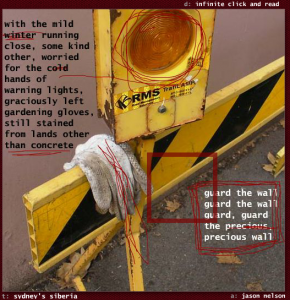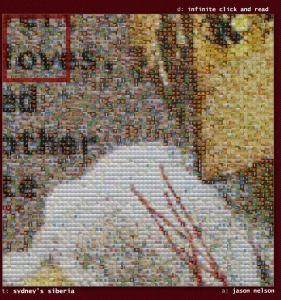Deena Larsen’s Firefly is a fascinating electronic literature piece that enriches and adds valuable depth (quite literally) to a traditional structure of written poetry to augment the reader’s experience. Although Firefly may at first appear to be a normal poem, Larsen challenges typical linear narrative structure and utilizes Flash hypertext to add interactive layers to the piece. The digital poem consists of six stanzas, each “five lines ‘long’ and six lines ‘deep’” (Larsen). The “depth” derives from the hypertext – each line of the stanza is clickable and rotates between six possible strings of text for that line. Larsen uses this affordance to take Firefly beyond the bounds of linearity and provide self-described “multi-dimensional spaces for meaning, subtext, and context” (Larsen).
Creating a meaningful reader experience is critical for crafting a successful electronic literature project, and Firefly puts the reader experience first and foremost on its list of priorities. Larsen strikes an effective balance between authorial intent and open interpretation by providing a malleable, responsive work that still manages to fit within the atmosphere she desires. The content itself of Firefly exists within a certain haunting, mysterious aesthetic. Larsen uses a dark, murky color scheme of greens and browns for the background, with eerie brick structures reminiscent of a graveyard. The poem itself describes a narrator’s fleeting nighttime encounter with a firefly, and the narrator heavily romanticizes the firefly while giving vivid descriptions of its movements. There is a certain level of anthropomorphizing, and the narrator appears to view himself and the firefly as equals. On the surface it appears to be an insignificant encounter, yet the narrator’s heartfelt musings show that it is clearly a powerful moment for him. In one possible reading of the poem, the narrator recounts, “I pour a life’s memories out before him like spilled wine to break the silence” (Larsen, Stanza 5). Larsen evokes sympathy from the reader, as she describes the narrator’s struggle to communicate with the firefly. The final stanza is arguably the strongest of the poem, with one possible reading being “The moment breaks as if nothing had existed…leaving nothing inside to remember what lies afterwards” (Larsen, Stanza 6). A chance encounter that appears trivial ends up leaving a gaping emptiness for the narrator, and it is difficult not to empathize with his sadness. It is true that Larsen leaves it up to the reader to change the lines to create powerful emotional messages (the two quotations referenced above are manipulated stanzas rather than the default configurations). However, these possibilities are specifically designed to remain in line with the gloomy ambience that Larsen seeks to establish. In her book Electronic Literature: New Horizons for the Literary, N. Katherine Hayles describes the challenges that E-Lit writers face in trying to incorporate “conventional narrative devices such as rising tension, conflict, and denouement in interactive forms where the user determines sequence” (Hayles 16). Larsen takes these challenges head-on, and provides an interactive experience that is constructed to maintain its poignancy regardless of the user’s choices.
The power of Firefly is in its unique combination of surface simplicity and depth of meaning. The interchangeable lines are masterfully crafted and arranged such that any permutation provides a reasonably readable stanza. Larsen is successful in staying well-grounded and not trying to do too much with the project. That is not to say that her work lacks effort – at a UND Writer’s Conference in 2010, Larsen admitted to spending six months on Firefly, explaining that “getting everything to fit together takes a long time because you actually do have to sit there and think about these things” (Larsen 2010). By pouring so much effort into a small, focused work, Larsen creates a clean and rich final product. The depth of the project and the countless possible arrangements for the poem make it an E-Lit piece that is worth re-visiting many times, as each read will surely be a different experience.
Firefly certainly qualifies as electronic literature, and its literary merit is evident, though its technology and interface are not particularly ambitious or avant-garde within the realm of modern E-Lit pieces. Indeed, the project has an extra dimension that adds depth beyond the scope of traditional poetry, but at heart it is still simply a collection of words. The project could reasonably be re-created in a physical representation, but it would be more cumbersome to navigate. It is also important to bear in mind that Firefly was created in 2002, and making hypertext with flash is quite passé now while it might have been fairly innovative for a project at the time. It was likely for the better that Larsen was not overly ambitious in writing Firefly, and perhaps the project medium and structure itself can even be seen as a metaphor for the story it contains. The project’s presentation is simple on the exterior, yet it provides additional layers that add significant meaning and emotional depth. Similarly, the narrator’s encounter with the firefly could have easily been a bland moment in passing, but it turns out to be a beautifully melancholy interaction with unexpected vividness. While some E-Lit focuses heavily on interesting technology and exciting user experiences and perhaps lacks in literary merit, Firefly is towards the opposite end of the spectrum. Larsen’s technology is not flashy in any way, but she utilizes its affordances to their full extent in designing an enhanced poem.
Firefly serves as a valuable example that electronic literature can exist in an augmented digital medium without sacrificing contextual and sub-textual literary meaning. In The Language of New Media, Lev Manovich appears to disparage the merit of electronic literature, claiming that “all new media objects, whether created from scratch on computer or converted from analog media sources, are composed of digital code; they are numerical representations” (Manovich 27). Gould examines Manovich’s position in A Bibliographic Overview of Electronic Literature, arguing that his statements seem to “sever the literary from the work by effectively mathematimacizing e-poetries and e-literatures” (Gould). Gould is correct that Manovich is “rather harsh” (Gould) in his opinions, and indeed his blanket statements are disrespectful to electronic literature writers. The fact that digital literature works are stored as numerical data at the lowest level has hardly any impact on the majority of reader experiences with said works. E-Lit writers design their projects using words just like any other writer, and they choose to take advantage of (and be influenced by) certain technological media. At heart, an e-lit project is still a literary work, and does not deserve to be discredited based on its mathematical representation at the lowest level. Electronic literature works like Firefly should be praised, despite imperfections, for their efforts to push boundaries of scholarly tradition and provide an augmented experience that enables readers to think and feel in new ways.
Works Cited:
Gould, Amanda. “A Bibliographic Overview of Electronic Literature.” Electronic Literature Directory. N.p., n.d. Web. 28 Oct. 2014.
Hayles, Katherine. Electronic Literature: New Horizons for the Literary. Notre Dame, IN: U of Notre Dame, 2008. Print.
Larsen, Deena. Firefly. 2002. Web. http://poemsthatgo.com/gallery/fall2002/firefly/index.html.
Larsen, Deena. “Reading: Deena Larsen”. UND Writers Conference. 23 March 2010.
Manovich, L. (2001). The language of new media. Cambridge, Mass.: MIT Press.



